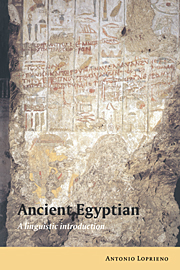Book contents
- Frontmatter
- Contents
- Preface
- Major Chronological Divisions of Egyptian History
- 1 The language of Ancient Egypt
- 2 Egyptian graphemics
- 3 Egyptian phonology
- 4 Elements of historical morphology
- 5 Nominal syntax
- 6 Adverbial and pseudoverbal syntax
- 7 Verbal syntax
- Epilogue
- Notes
- References
- Index of passages
- Index of morphemes
- Index of lexemes
- Index of topics
5 - Nominal syntax
Published online by Cambridge University Press: 08 December 2009
- Frontmatter
- Contents
- Preface
- Major Chronological Divisions of Egyptian History
- 1 The language of Ancient Egypt
- 2 Egyptian graphemics
- 3 Egyptian phonology
- 4 Elements of historical morphology
- 5 Nominal syntax
- 6 Adverbial and pseudoverbal syntax
- 7 Verbal syntax
- Epilogue
- Notes
- References
- Index of passages
- Index of morphemes
- Index of lexemes
- Index of topics
Summary
Introduction
Throughout its history, Egyptian displays a variety of patterns for sentences with nominal predicate. The predicate of such a sentence can be a nominal (NP) or an adjectival phrase (AdjP): rmt pw “it is a man (NP)” vs. nfr sw “he is good (AdjP).” At the syntactic level, bipartite patterns consist only of predicate and subject, as in the above sentences, whereas tripartite patterns display a copula as carrier of the nexus (rmt pw z3-nht “Sinuhe is a man”). Finally, considering also the pragmatic dimension, the typology of Egyptian nominal sentences shows a further distinction between unmarked structures, in which third person subjects follow it (rmt pw, nfr sw), whereas first and second person subjects tend to precede the predicate (jnk rmt “I am a man,” ntk nfr “you are good”), and marked patterns, which display a generalized preference for the specific subject to occupy the first position in the sentence (ntk hrw “you are Horus,” jn ntr mrr rmt.t “it is god who loves mankind”).
The nominal constructions to which this chapter is devoted are captured in table 5.1. We shall first consider the nominal patterns (section 5.2) and the syntactic structure in which an entire clause is embedded as predicate of a nominal sentence (section 5.3), and then move to the adjectival sentences (section 5.4). We will then devote some attention to the more complex nominal patterns such as possessive, interrogative, and existential sentences (sections 5.5–5.6) and to the impact of negation on nominal patterns (section 5.7). The last few sections will deal with the evolution of all types of nominal sentence in Late Egyptian, Demotic and Coptic (sections 5.8–5.11).
- Type
- Chapter
- Information
- Ancient EgyptianA Linguistic Introduction, pp. 103 - 143Publisher: Cambridge University PressPrint publication year: 1995



